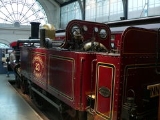
Metropolitan Railway A Class
Encyclopedia
The Metropolitan Railway
A Class were 4-4-0T steam locomotives built to work the first of the London Underground lines. They were built by Beyer, Peacock and Company
from 1864.
The A Class, together with the later and similar B Class, eventually numbered 66 locomotives. All were equipped with condensing apparatus
for operating in the inner London tunnels of the Circle Line, Hammersmith and City Line and the southern end of the Metropolitan Mainline
. Part of this equipment was a vent from the water tanks that resembled a second chimney in front of the cab.
As built, the locomotives did not have cabs, just a simple spectacle plate. Once the railway was extended to include substantial lengths of surface running, the locomotives were fitted with cabs.
The first 18 locomotives originally carried names, but as the class was superseded, these were removed.
These locomotives were made redundant by the electrification of the inner London lines in 1905/1906 when many were sold or scrapped. Around 13 locomotives were retained for shunting, Departmental work and working trains over the Brill Tramway. The purchase of other locomotives, the closure of the Brill tramway (in 1935) and the transfer of freight duties to the LNER saw all but one of these remaining locomotives sold or scrapped around 1936.
MetR No. 23 (LT No.45) survived and is now preserved at the London Transport Museum
.
Metropolitan railway
Metropolitan Railway can refer to:* Metropolitan line, part of the London Underground* Metropolitan Railway, the first underground railway to be built in London...
A Class were 4-4-0T steam locomotives built to work the first of the London Underground lines. They were built by Beyer, Peacock and Company
Beyer, Peacock and Company
Beyer, Peacock and Company was an English railway Locomotive manufacturer with a factory in Gorton, Manchester. Founded by Charles Beyer and Richard Peacock, it traded from 1854 until 1966...
from 1864.
The A Class, together with the later and similar B Class, eventually numbered 66 locomotives. All were equipped with condensing apparatus
Steam locomotive condensing apparatus
A steam locomotive condensing apparatus differs in purpose from the usual closed cycle steam engine condenser, in that its function is primarily either to recover water, or to avoid excessive emissions to the atmosphere, rather than maintaining a vacuum to improve both efficiency and power...
for operating in the inner London tunnels of the Circle Line, Hammersmith and City Line and the southern end of the Metropolitan Mainline
Metropolitan Line
The Metropolitan line is part of the London Underground. It is coloured in Transport for London's Corporate Magenta on the Tube map and in other branding. It was the first underground railway in the world, opening as the Metropolitan Railway on 10 January 1863...
. Part of this equipment was a vent from the water tanks that resembled a second chimney in front of the cab.
As built, the locomotives did not have cabs, just a simple spectacle plate. Once the railway was extended to include substantial lengths of surface running, the locomotives were fitted with cabs.
The first 18 locomotives originally carried names, but as the class was superseded, these were removed.
These locomotives were made redundant by the electrification of the inner London lines in 1905/1906 when many were sold or scrapped. Around 13 locomotives were retained for shunting, Departmental work and working trains over the Brill Tramway. The purchase of other locomotives, the closure of the Brill tramway (in 1935) and the transfer of freight duties to the LNER saw all but one of these remaining locomotives sold or scrapped around 1936.
MetR No. 23 (LT No.45) survived and is now preserved at the London Transport Museum
London's Transport Museum
The London Transport Museum, or LT Museum based in Covent Garden, London, seeks to conserve and explain the transport heritage of Britain's capital city...
.

